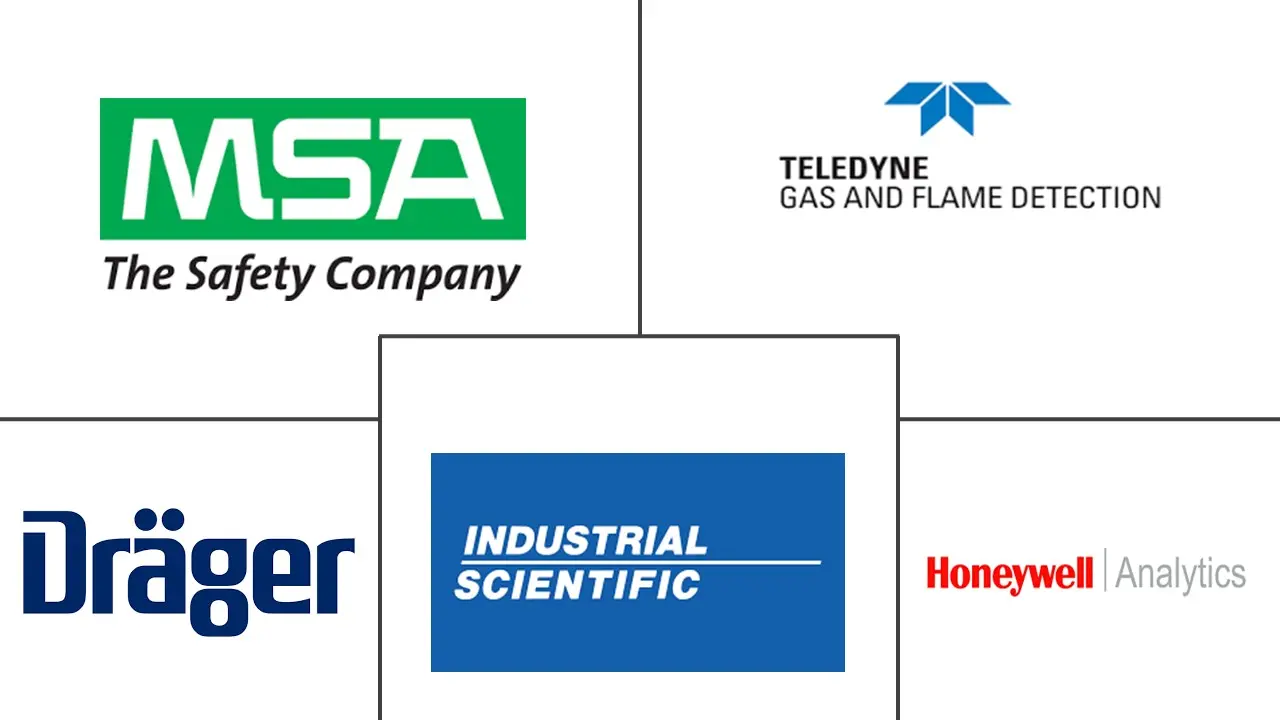Asia Pacific Gas Detector Market Size and Share
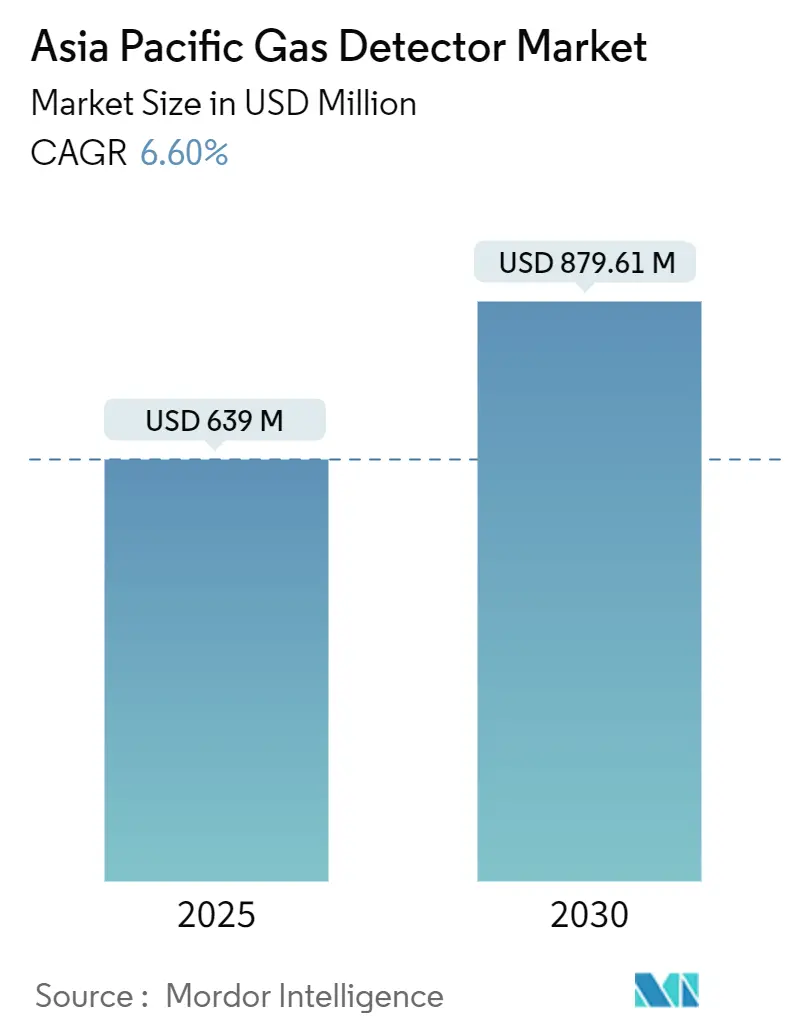
Asia Pacific Gas Detector Market Analysis by Mordor Intelligence
The Asia Pacific gas detector market size is valued at USD 639 million in 2025 and is forecast to reach USD 896.61 million by 2030, expanding at a 7.01% CAGR across the period. Accelerating industrialization, stringent workplace-safety requirements, and multi-billion-dollar oil, gas, and petrochemical projects continue to stimulate equipment upgrades across fixed, portable, and wireless detection platforms. China’s dominant industrial base anchors regional demand, while India’s manufacturing expansion and Smart Cities Mission fuel rapid incremental growth. Wired systems retain a deployment edge because of established infrastructure, yet wireless architectures gain ground as IIoT adoption eases brownfield retrofits and supports predictive maintenance analytics. Robust safety mandates ranging from Malaysia’s Occupational Safety and Health Amendment 2022 to South Korea’s Industrial Safety and Health Act raise minimum compliance thresholds, prompting enterprises to standardize multi-gas monitoring throughout confined-space operations. Competitive intensity rises as multinational leaders integrate cloud connectivity, self-calibrating sensors, and AI-driven diagnostics, while regional suppliers leverage localized production and service networks to win cost-sensitive projects.
Key Report Takeaways
- By communication type, wired systems led with 48.6% of the Asia Pacific gas detector market share in 2024, whereas wireless solutions are forecast to post a 9.0% CAGR through 2030.
- By detector type, fixed installations accounted for 48.2% of the Asia Pacific gas detector market size in 2024, while portable detectors are projected to grow at an 8.5% CAGR to 2030.
- By end-user industry, oil and gas captured 37.2% of the Asia Pacific gas detector market share in 2024; utilities represent the fastest-growing application, advancing at an 8.7% CAGR over the outlook period.
- By geography, China held 35.8% of regional revenue in 2024, yet India is poised to expand at an 8.9% CAGR through 2030.
Asia Pacific Gas Detector Market Trends and Insights
Drivers Impact Analysis
| DRIVER | (~) % IMPACT ON CAGR FORECAST | GEOGRAPHIC RELEVANCE | IMPACT TIMELINE |
|---|---|---|---|
| Stringent workplace safety regulations | +1.8% | China, India, Southeast Asia | Medium term (2-4 years) |
| Expansion of oil and gas and petrochemical capex | +1.5% | Southeast Asia, India, spillover to China | Long term (≥ 4 years) |
| Rapid uptake of IIoT-enabled wireless detection | +1.2% | Japan, Korea, Australia; early regional adoption | Short term (≤ 2 years) |
| Smart-city air-quality mandates | +0.9% | Major Asia-Pacific urban centers | Medium term (2-4 years) |
| Hydrogen-economy pilots (H₂ sensors) | +0.7% | Japan, Korea, Australia | Long term (≥ 4 years) |
| China GB/T-2025 methane-leak rules | +0.6% | National China; influence on regional norms | Short term (≤ 2 years) |
| Source: Mordor Intelligence | |||
Stringent workplace-safety regulations across the Asia-Pacific heavy industries
National authorities continue to ratchet up occupational-safety statutes, compelling manufacturers, refiners, and utilities to install certified multi-gas monitors across confined spaces and hazardous process areas. Malaysia’s Occupational Safety and Health Amendment 2022 obliges every employer to appoint safety coordinators and document atmospheric-monitoring practices, boosting fixed-detector penetration across chemical and palm-oil processing clusters.[1]Source: Federation of Malaysian Manufacturers, “Businesses in a Bind Over Safety,” fmm.org.my Australia enforces intrinsically safe instrumentation under AS/NZS standards for confined-space entry, while South Korea mandates five-gas measurement (O₂, CO, LEL, H₂S, CO₂) at worksites, standardizing demand for portable multi-gas detectors.[2]Source: Safegas Korea, “MicMeta-5C Five-Gas Measurement Mandate,” safegaskorea.kr Corporate harmonization plays a multiplier role: multinationals export internal safety protocols to satellite facilities in Vietnam and Indonesia, driving uniform procurement of networked gas-detection platforms across the supply chain. The result is a structural uplift in baseline sensor specifications, faster response times, wider operating ranges, and digital calibration logs that favour differentiated technology providers.
Expansion of oil and gas and petrochemical projects in emerging Asia-Pacific economies
Southeast Asia’s petrochemical build-out supplies the region’s single largest capital-expenditure catalyst for detection equipment. Projects such as Malaysia’s USD 3.5 billion Pengerang Energy Complex and Indonesia’s 555 km Dumai–Sei Mangkei transmission pipeline embed continuous monitoring for volatile organic compounds, methane, and H₂S, creating a durable pull-through for fixed sensor arrays. Thailand’s PTTEP allocates USD 21.2 billion over five years to upstream gas and LNG, magnifying offshore platform demand for flameproof detectors, while Vietnam’s Long Son complex adds cryogenic ethane tanks requiring leak-before-break detection architectures. The swing toward integrated refinery-petrochemical hubs and deep-water gas fields raises hazard complexity, accelerating the adoption of networked infrared, ultrasonic, and laser-based detectors with continuous self-diagnostics.
Rapid uptake of IIoT-enabled wireless gas detection platforms
Industrial Internet of Things integration refashions the cost-benefit calculus for safety managers by eliminating cable runs, enabling asset-health analytics, and facilitating real-time alerts across distributed sites. MSA Safety’s ALTAIR io 4 combines CAT-M LTE connectivity with “Shared Alerts”, instantly notifying nearby workers when a team member triggers an alarm. Emerson’s Rosemount 928 Wireless Monitor leverages WirelessHART to stream diagnostics to the plant historian, while tool-less sensor replacement reduces maintenance downtime.[3]Source: Emerson Electric Co., “Gas Detection in Power Generation,” emerson.com Cloud-based dashboards such as Industrial Scientific’s iNet Control+ aggregate fleet data, automate compliance records, and predict sensor-end-of-life, shrinking calibration costs. Wireless systems, therefore, penetrate brownfield petrochemical sites, upstream well pads, and temporary turnaround projects, despite higher per-unit sensor prices.
Smart-city air-quality mandates boosting demand for IoT-linked detectors
Urban-development programs embed environmental monitoring into the core of smart-city platforms, extending gas-detection use cases beyond heavy industry. India’s 100-city Smart Cities Mission funds integrated command-and-control centers that track industrial emissions, solid-waste decomposition gases, and potable-water odorants.[4]Source: IEEE Smart Cities, “Smart City Mission of India,” smartcities.ieee.org China’s GB 50325-2020 mandates testing for formaldehyde, xylene, benzene, and radon in new civil buildings, steering procurement toward multi-parameter sensors certified for occupancy health standards. Municipal gas utilities deploy smart meters with embedded leak detection, such as the 650,000 prepaid units financed under Bangladesh’s ADB-backed installation program. Guangzhou’s gas-management ordinance layers QR-code cylinder tracking with centralized cloud dashboards, showcasing how urban regulators harness IoT networks for public-safety oversight.[5]Source: Guangzhou Municipal Justice Bureau, “Measures of Guangzhou Municipality for Gas Management,” sfj.gz.gov.cn These initiatives distribute incremental demand across portable, wall-mount, and meshed sensor nodes linked to GIS dashboards.
Restraints Impact Analysis
| RESTRAINT | (~) % IMPACT ON CAGR FORECAST | GEOGRAPHIC RELEVANCE | IMPACT TIMELINE |
|---|---|---|---|
| High upfront CAPEX for advanced fixed systems | -1.1% | SME-heavy markets in Southeast Asia and India | Medium term (2-4 years) |
| Post-pandemic budget compression among SME manufacturers | -0.8% | Thailand, Vietnam, and Malaysia are manufacturing hubs | Short term (≤ 2 years) |
| Shortage of certified calibration technicians | -0.6% | Vietnam, Indonesia, wider Southeast Asia | Medium term (2-4 years) |
| Tariff-driven sensor-module cost volatility | -0.4% | China's supply chains with Asia-Pacific spillover | Short term (≤ 2 years) |
| Source: Mordor Intelligence | |||
High upfront CAPEX for advanced fixed detection systems
Price sensitivity remains the principal adoption hurdle for small and medium manufacturers. Installation of networked infrared detectors with redundancy loops can cost multiples of annual safety budgets, especially when compliance training already absorbs MYR 500–900 per coordinator in Malaysia. Hardware savings achieved by regional suppliers are partly offset by integration, calibration gas, and cloud subscription fees, prolonging payback periods. Multilateral credit facilities exist, yet awareness among SMEs is limited, delaying mass roll-outs in Thailand’s automotive supply chain and Vietnam’s garment clusters. Vendors respond with subscription-based “gas-detection-as-a-service” models bundling hardware, calibration, and software into monthly operating expenditures, but regulatory acceptance of service-model compliance certificates varies across jurisdictions, constraining scale.
Post-pandemic budget compression among SME manufacturers
Lingering pandemic-era liquidity stress forces SMEs to prioritize core production investments over safety-system upgrades. Asian Development Bank’s 2024 survey indicates working-capital loans remain skewed toward export-credit lines rather than safety infrastructure, even though standards enforcement has tightened. Consequently, many dyeing mills and furniture workshops extend calibration intervals or rely on single-gas spot checkers rather than holistic multi-gas networks, heightening incident risk. Enforcement agencies in Malaysia and Indonesia consequently stage compliance sweeps targeting high-risk sectors, yet financial relief such as grant-backed detector procurement remains in early pilot phases. Until macro-economic recovery broadens profit margins, unit growth among SMEs will lag top-line regional expansion.
Segment Analysis
By Communication Type: Wireless Gains Despite Wired Dominance
The wired architecture retained 48.6% of the Asia Pacific gas detector market share in 2024, mainly because process industries already possess intrinsic analogue and digital cabling, and failure-mode-and-effect analyses favor redundant, hard-wired loops for life-critical alarms. Wireless, however, is forecast to compound at 9.0% through 2030 as battery-powered nodes slash installation labor, a major cost component in brownfield facilities. LTE-M and NB-IoT modules coupled with over-the-air firmware updates simplify large-scale asset-management cycles, while WirelessHART meshes satisfy determinism requirements in continuous processes. Field trials in Korean shipyards confirm that wireless detectors cut deployment time by 60% and eliminate cable-tray rework.
Portable devices increasingly embed BLE beacons and cloud gateways, blending portability with fleet-wide visibility. Fixed-wireless hybrids emerge where ATEX-rated power lines feed detectors, but signal backhaul occurs via 2.4 GHz mesh, avoiding copper cable runs over rotating machinery and hazardous zones. Telecom-operator partnerships in Japan and Australia enable bundled SIM data plans, reducing recurring connectivity charges for end users. Given these structural advantages, wireless is poised to erode the wired share, yet legacy system inertia and corporate qualification cycles suggest wired dominance persists at least until 2027.
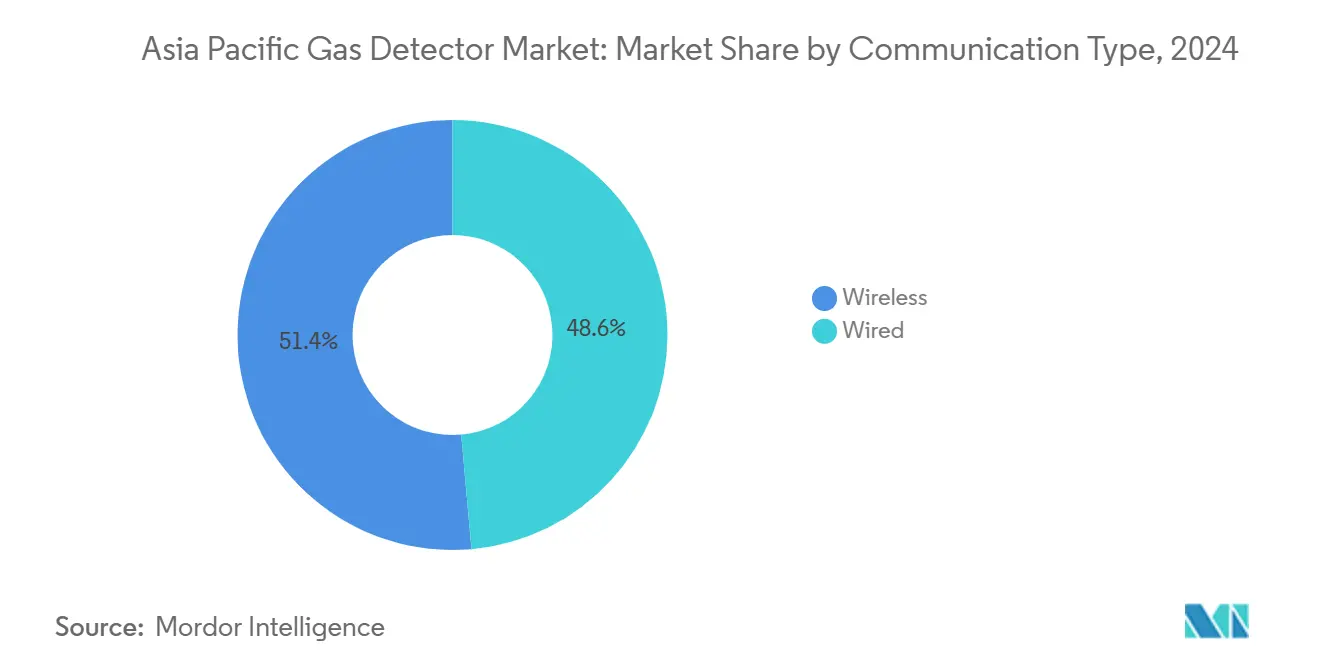
By Detector Type: Fixed Systems Lead Amid Portable Growth
Fixed systems occupied 48.2% of the Asia Pacific gas detector market size in 2024 on the back of mandatory continuous monitoring in refineries, LNG terminals, and power plants. Infrared point detectors configured for 0–100% LEL hydrocarbon measurement remain the default in process areas, while open-path lasers guard perimeter fence lines. Portable detectors, nonetheless, are poised for the fastest 8.5% CAGR, supported by regulatory five-gas measurement standards in South Korean and Australian confined-space codes and by the need for flexibility during maintenance turn-arounds. Asia Pacific gas detector market share for portable devices is on track as battery runtimes extend beyond 25 hours and sensor swap-out becomes tool-less.
Technological miniaturization allows four-gas capabilities within palm-sized enclosures weighing under 100 g, improving worker compliance. Calibration-free disposable single-gas units meet entry-level needs for SMEs, while multi-gas models integrate man-down alarms and GPS beacons. Transportable detectors bridge gaps during plant commissioning or pipeline hot-work, operating as stand-alone nodes with wireless backhaul to central command. The resulting product stratification enables suppliers to segment portfolios by price, spec, and service bundle, maximizing revenue capture across user tiers.
By End-User Industry: Oil and Gas Leadership with Utilities Surge
Oil and gas operations generated 37.2% of the Asia Pacific gas detector market revenue in 2024, reflecting stringent process-safety mandates and the hazard spectrum spanning benzene, H₂S, and combustible gases. Upstream and midstream projects in Malaysia, Thailand, and Australia continue to specify triple-redundant fixed detectors plus flame and ultrasonic additions, locking in high average selling prices. In contrast, the utilities segment, covering power generation and gas-distribution networks, is projected to grow at an 8.7% CAGR, propelled by hydropower refurbishments, coal-to-gas conversion projects, and hydrogen co-firing pilots across Japan and Korea.
Chemical and petrochemical users maintain steady sensor replacements driven by catalyst change-outs and feedstock diversification. Water and wastewater utilities boost dissolved-gas monitoring to prevent anaerobic hazards in digesters, while metal-mining operations invest in methane and oxygen monitors to comply with New South Wales Mine Design Registration requirements. The competitive implication is a broader mix of detector types, infrared, electrochemical, and photoionization, tailored to industry-specific gas profiles.
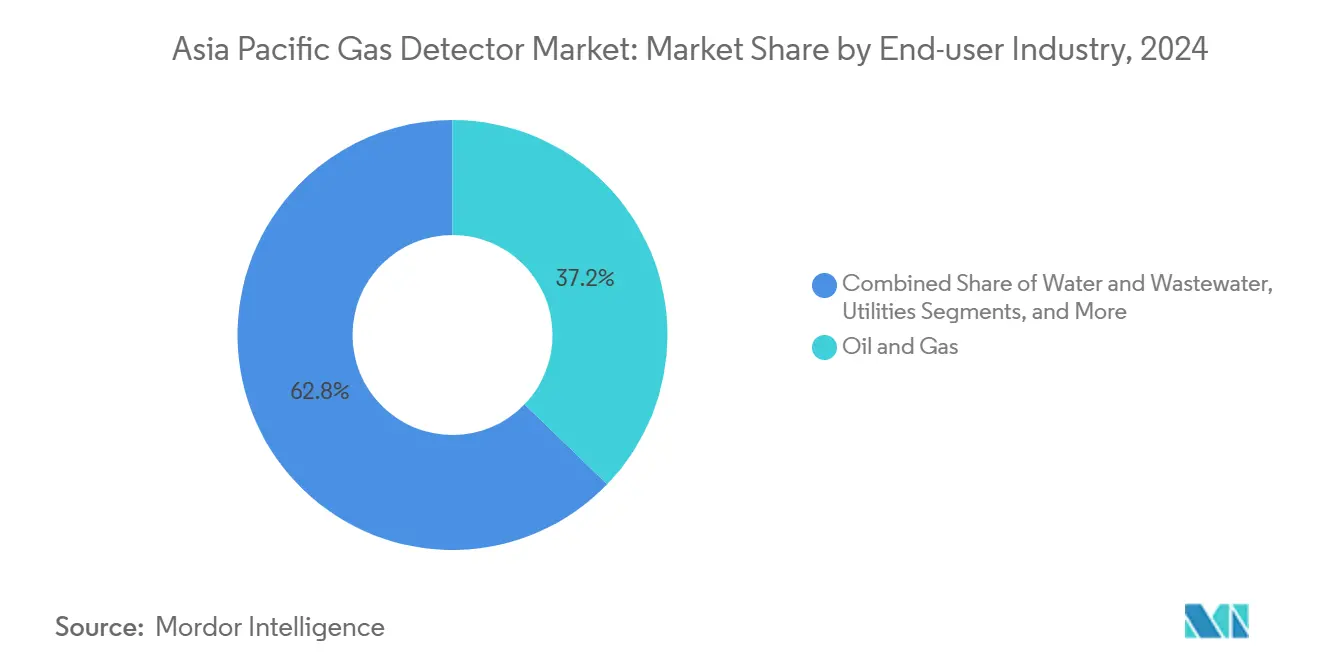
Note: Segment shares of all individual segments available upon report purchase
Geography Analysis
China captured 35.8% of the Asia Pacific gas detector market share in 2024, benefiting from extensive industrial clusters and stringent standards such as GB 50325-2020, which prescribes multi-parameter air-quality testing in new civil buildings. Ongoing municipal pipeline upgrades under GB/T-2025 add thousands of continuous-monitoring nodes, and city-level ordinances in Guangzhou require QR-coded LPG cylinder tracking plus real-time leak alerts. Domestic suppliers leverage local certifications to penetrate SME segments, while export-oriented factories procure global-brand detectors to match multinational corporate standards.
India, the fastest-growing geography at an 8.9% CAGR, mobilizes demand through 100-smart-city deployments, Make-in-India manufacturing incentives, and progressive workplace-safety codes. Integration of gas detection within municipal solid-waste processing and water-treatment PPP contracts widens application scope. Adoption accelerates further as power-generation projects adopt gas turbines configured for hydrogen blends, requiring H₂ partial-discharge monitors.
Japan and South Korea sustain mid-single-digit growth via hydrogen-economy pilots and stringent confined-space regulations. Japan’s Ministry of Economy, Trade and Industry backs liquid-hydrogen demonstration voyages, mandating class-society approval of H₂-specific detectors on board carriers. Australia and New Zealand contribute stable demand anchored by mining safety and refinery refurbishments; open-path IR and ultrasonic detectors dominate LNG-export terminals here. Southeast Asia, Indonesia, Malaysia, Thailand, and Vietnam collectively represent the region’s highest greenfield opportunity, thanks to USD 220 billion worth of gas and petrochemical projects in the pipeline, each specifying extensive detector networks.
Competitive Landscape
The regional competitive arena is moderately fragmented. Honeywell, MSA Safety, and Draegerwerk command premium positions through global certifications, vertically integrated sensor technology, and comprehensive service footprints. Honeywell’s 2025 acquisition of Norcross Safety Products broadens PPE partnership, enabling bundled detector-plus-respirator tenders in refinery turn-arounds. MSA’s local assembly partnerships cut lead times and circumvent import duties, a decisive advantage in India and Saudi Arabia. Industrial Scientific differentiates itself via its iNet SaaS platform that automates compliance logs and predicts sensor end-of-life, lowering the total cost of ownership for fleet operators.
Regional manufacturers Hanwei Electronics, New Cosmos Electric, and Riken Keiki capture share among SMEs by offering cost-optimized detectors compatible with domestic calibration gases. Their agile engineering cycles allow rapid localization of firmware for local languages and alarm set-points tied to national standards. Technology competition centers on self-calibrating sensors, long-life Li-SOCl₂ batteries, and intrinsically safe Bluetooth gateways. As hydrogen applications rise, component suppliers race to certify palladium-alloy catalytic sensors with sub-0.4% LEL detection thresholds, opening niches for new entrants specialized in H₂.
Strategic moves increasingly couple hardware with digital ecosystems. Draeger’s INARA digital safety guard extends multi-site monitoring through wearable beacons, while Teledyne integrates optical gas imaging with methane quantification analytics for fugitive-emission reporting. Market entrance barriers remain moderate: certification costs and service-network investments deter opportunistic entrants, yet local assembly rules in Indonesia and India foster domestic-supplier emergence, intensifying price competition in low-to-mid tier segments.
Asia Pacific Gas Detector Industry Leaders
Honeywell Analytics Inc.
Drägerwerk AG & Co. KGaA
MSA Safety Incorporated
Teledyne Gas & Flame Detection
Industrial Scientific Corporation
- *Disclaimer: Major Players sorted in no particular order
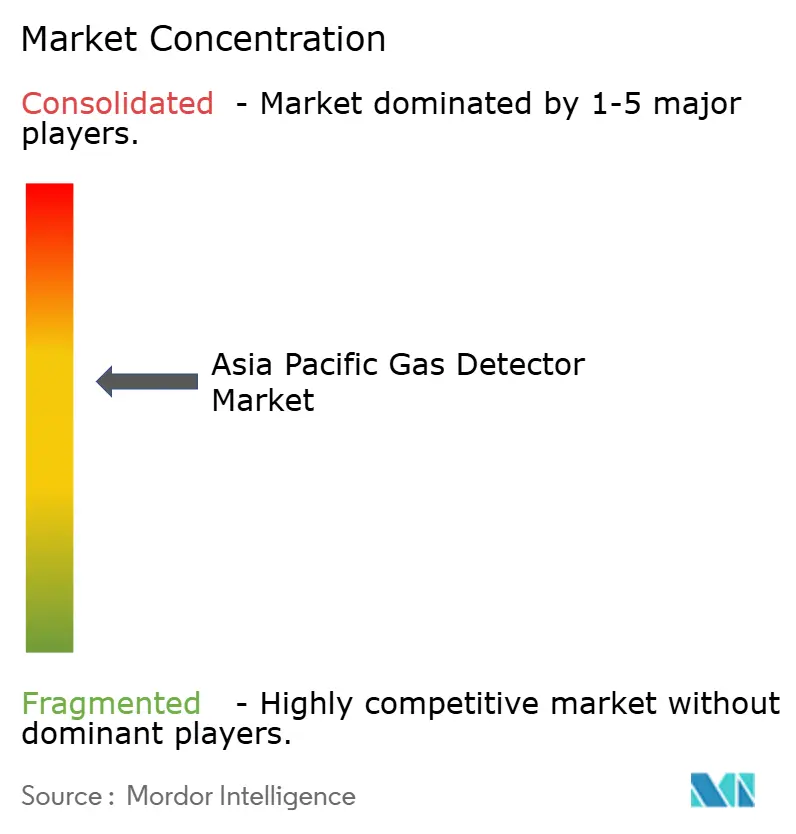
Recent Industry Developments
- March 2025: SCGC awarded China Tianchen Engineering Corporation and Petrovietnam Technical Service Corporation an EPC contract for 55,000-ton cryogenic ethane tanks at the Long Son Petrochemicals complex, Vietnam; completion slated for 2027.
- February 2025: LAVO Renewables established a Tokyo subsidiary after selection by JETRO’s Invitation Program, supporting Japan’s green-hydrogen supply-chain build-out.
- January 2025: POSCO Holdings and Hysata signed joint-development agreements to commercialize 95%-efficiency hydrogen electrolysers, following a USD 111 million Series B investment.
- January 2025: PTTEP unveiled a USD 21.2 billion five-year capex plan emphasizing upstream gas and LNG supply-chain projects across Thailand and international assets.
Asia Pacific Gas Detector Market Report Scope
- The gas detector measures and indicates the concentration of certain gases in the air via different technologies. These are characterized by the type of gases they can detect across the environment. Within this broad categorization, they are also defined by their technology. The study describes the Asia Pacific gas detectors market based on the end-user industry, which includes oil and gas, chemical and petrochemical, water and wastewater, metal and mining, power generation and transmission, and other end-user industries.
- The Asia Pacific Gas Detector market is segmented by Type (Fixed (Toxic Gas Detectors, Combustible Gas Detectors), Portable (Single-gas, Multi-gas)), End-user Verticals (Oil and Gas, Chemical and Petrochemical, Water and Wastewater, Power Generation, Metals and Mining, Food and Beverage), and Country.
| Wired |
| Wireless |
| Fixed | Electrochemical |
| Semiconductor | |
| Photo-ionization | |
| Catalytic | |
| Infra-red | |
| MEMS | |
| Portable and Transportable | Multi-Gas |
| Single-Gas |
| Oil and Gas |
| Chemicals and Petrochemicals |
| Water and Wastewater |
| Metal and Mining |
| Utilities |
| Other End-User Industries |
| China |
| Japan |
| India |
| South Korea |
| Southeast Asia |
| Australia and New Zealand |
| Rest of Asia-Pacific |
| By Communication Type | Wired | |
| Wireless | ||
| By Detector Type | Fixed | Electrochemical |
| Semiconductor | ||
| Photo-ionization | ||
| Catalytic | ||
| Infra-red | ||
| MEMS | ||
| Portable and Transportable | Multi-Gas | |
| Single-Gas | ||
| By End-User Industry | Oil and Gas | |
| Chemicals and Petrochemicals | ||
| Water and Wastewater | ||
| Metal and Mining | ||
| Utilities | ||
| Other End-User Industries | ||
| By Country | China | |
| Japan | ||
| India | ||
| South Korea | ||
| Southeast Asia | ||
| Australia and New Zealand | ||
| Rest of Asia-Pacific | ||
Key Questions Answered in the Report
What is the current value of the Asia Pacific gas detector market?
The market is valued at USD 639 million in 2025 and is projected to reach USD 896.61 million by 2030.
Which detector type is growing fastest in the Asia Pacific?
Portable multi-gas detectors are advancing at an 8.5% CAGR due to heightened confined-space safety protocols.
Why are wireless gas detectors gaining traction?
Wireless systems cut installation labor, enable IIoT analytics, and support predictive maintenance, driving a 9.0% CAGR.
Which country leads demand for gas detectors in the Asia Pacific?
China holds the largest share at 35.8% thanks to comprehensive industrial and municipal safety regulations.
What drives utilities-sector demand for detectors?
Expansion of power-generation capacity and hydrogen co-firing pilots push utilities toward integrated H? and combustible-gas monitoring.
